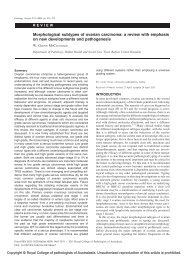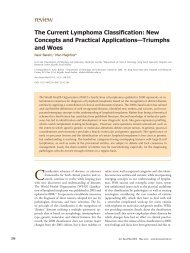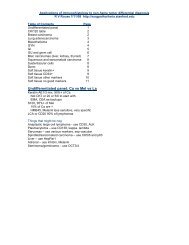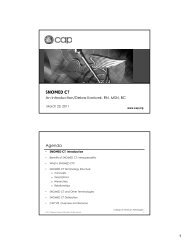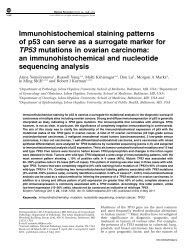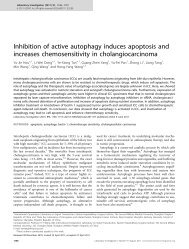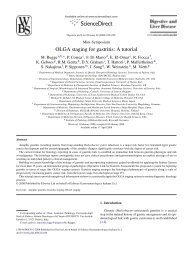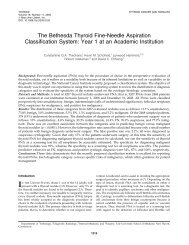Squamous cell and adenosquamous carcinomas of ... - BPA Pathology
Squamous cell and adenosquamous carcinomas of ... - BPA Pathology
Squamous cell and adenosquamous carcinomas of ... - BPA Pathology
You also want an ePaper? Increase the reach of your titles
YUMPU automatically turns print PDFs into web optimized ePapers that Google loves.
<strong>Squamous</strong> <strong>cell</strong> <strong>carcinomas</strong> <strong>of</strong> the gallbladder<br />
1072 JC Roa et al<br />
cases (4%) were <strong>adenosquamous</strong> <strong>carcinomas</strong> (25–<br />
99% <strong>of</strong> the tumor was squamous), <strong>and</strong> 8 (1%) were<br />
pure squamous <strong>cell</strong> <strong>carcinomas</strong>. The remaining 7<br />
with o25% squamous component were classified as<br />
adeno<strong>carcinomas</strong> with focal squamous change <strong>and</strong><br />
excluded.<br />
The patients were 27 females <strong>and</strong> 7 males (female/<br />
male ratio was 3.8, same as in gallbladder adenocarcinoma).<br />
Mean age <strong>of</strong> the patients was 65 years<br />
(versus 64 in gallbladder adenocarcinoma) with a<br />
range <strong>of</strong> 26–81 years. In only 13%, there was a<br />
preoperative clinical suspicion <strong>of</strong> malignancy.<br />
Pathological Features<br />
Macroscopic features<br />
The median <strong>and</strong> average tumor sizes were 2.5 <strong>and</strong><br />
3.1 cm, respectively (versus 2.4 <strong>and</strong> 2.7 in the<br />
control group <strong>of</strong> gallbladder adenocarcinoma;<br />
P ¼ 0.42). In 58%, the tumor was not apparent even<br />
under macroscopic examination; carcinoma formed<br />
plaque-like mural thickening <strong>and</strong> induration indistinguishable<br />
from cholecystitis. In the remainder,<br />
there were irregular <strong>and</strong> variable amounts <strong>of</strong> nodular<br />
arrangements (Figure 1). The mucosal aspect <strong>of</strong> the<br />
tumor was ulcerated <strong>and</strong> hemorrhagic in some<br />
cases. Two cases had friable papillary/polypoid<br />
projections (Figure 1) consistent with an intracholecystic<br />
papillary tubular component. Of the tumors,<br />
39% were located in the fundus, 15% in the lower<br />
third, 15% in the body <strong>and</strong> 31% had invaded more<br />
than one gallbladder segment. The exact incidence<br />
<strong>of</strong> gallstones could not be determined because in<br />
many cases, the gallstones had been removed by the<br />
surgeons as requested by the patients <strong>and</strong> this<br />
occurrence was not documented (<strong>and</strong> could not be<br />
verified accurately).<br />
Microscopic features<br />
A total <strong>of</strong> 65% (17/26) <strong>of</strong> ASCs had focal keratinization,<br />
whereas others were poorly differentiated;<br />
however, 88% (7/8) <strong>of</strong> pure squamous <strong>cell</strong> <strong>carcinomas</strong><br />
had substantial keratinization including pearl<br />
formation <strong>and</strong> dyskeratotic <strong>cell</strong>s (Figure 2). Four<br />
cases (12%) revealed squamous metaplasia in the<br />
adjacent mucosa (Figure 3). Metaplastic foci had<br />
variable degrees <strong>of</strong> atypia. Six cases revealed focal<br />
sarcomatoid appearance with <strong>of</strong>ten pleomorphic<br />
spindle <strong>cell</strong>s (Figure 4). Five displayed comedolike<br />
central necrosis in the large infiltrating squamous<br />
nests. Focal clear <strong>cell</strong> change was observed<br />
in five cases (Figure 5), <strong>and</strong> in one <strong>of</strong> these the tumor<br />
exhibited renal <strong>cell</strong> carcinoma-like pattern with<br />
alveolar growth <strong>and</strong> delicate vasculature. Interestingly,<br />
in three cases there was a peculiar microcystic<br />
change with accumulation <strong>of</strong> proteinaceouslike<br />
material within the cystic spaces (Figure 6).<br />
Figure 2 Pure squamous <strong>cell</strong> carcinoma with extensive keratinization<br />
including pearl formation <strong>and</strong> dyskeratotic <strong>cell</strong>s (inset).<br />
Figure 1 Adenosquamous carcinoma characterized with a broadbased<br />
ulcer<strong>of</strong>ungating mass located in the fundus.<br />
Figure 3 Adjacent gallbladder mucosa showing squamous metaplasia<br />
<strong>and</strong>/or dysplasia in four cases.<br />
Modern <strong>Pathology</strong> (2011) 24, 1069–1078




